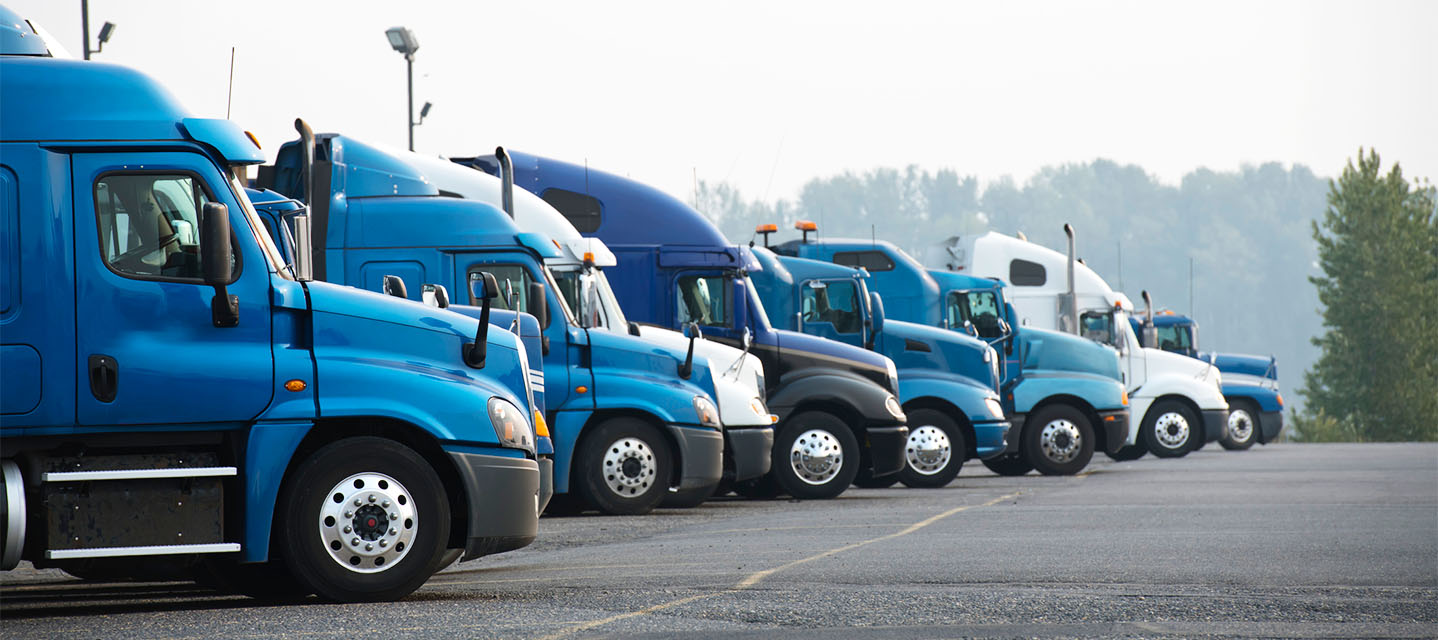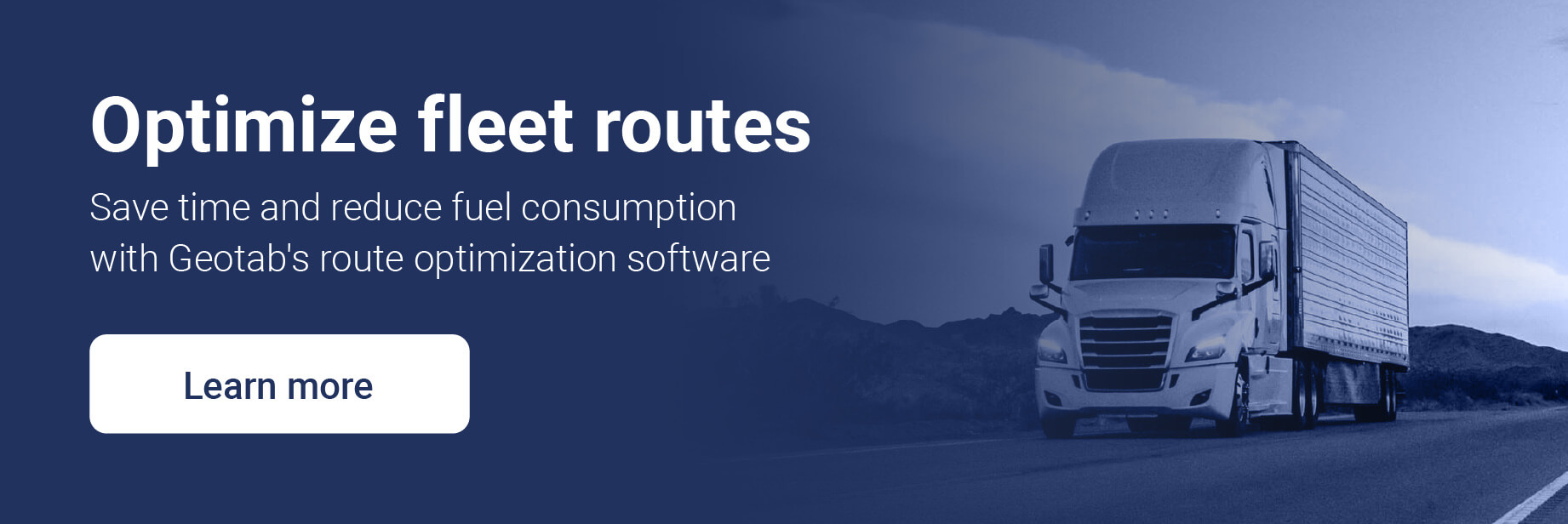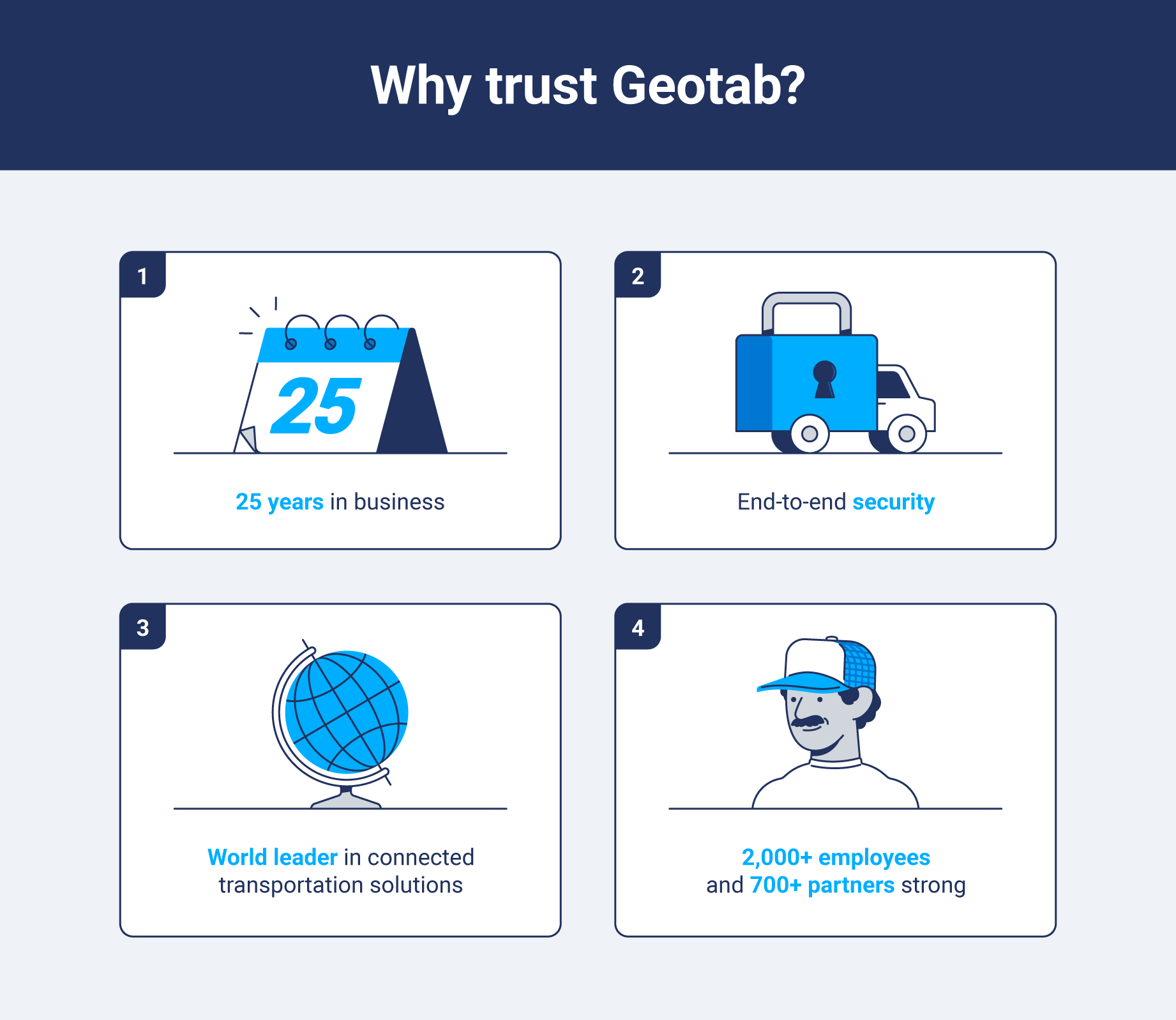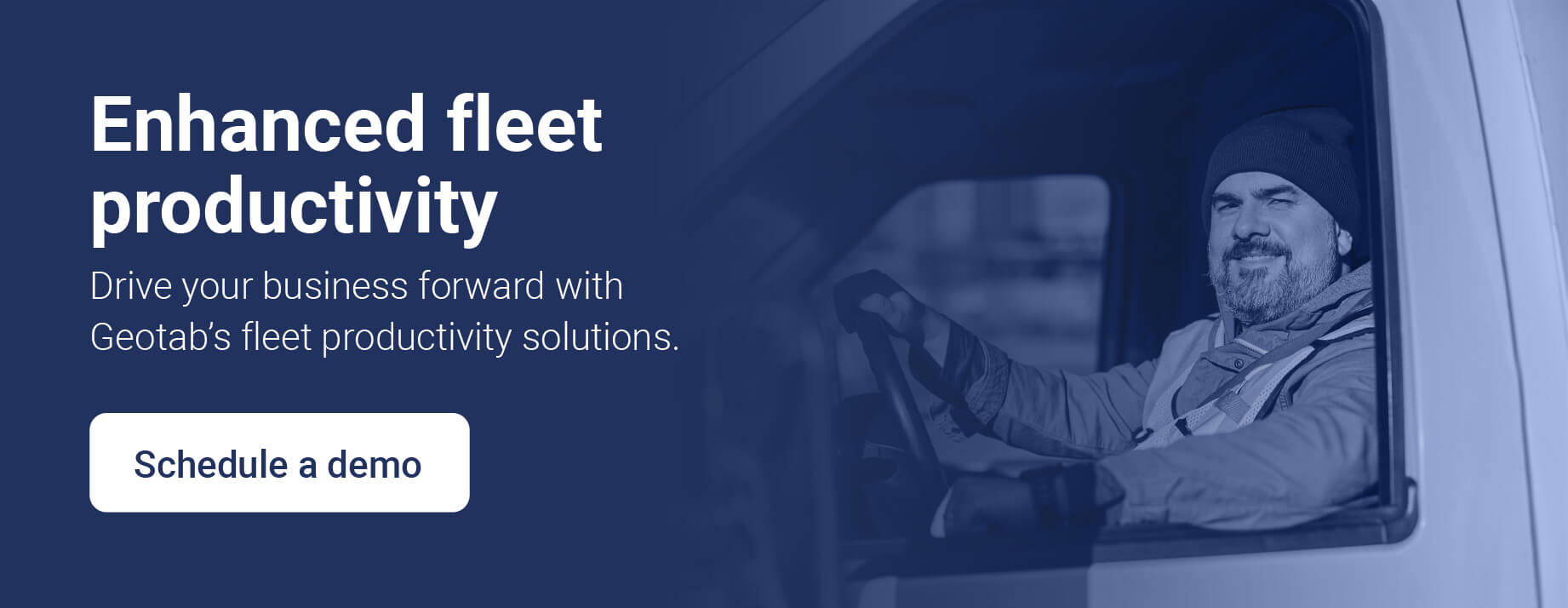Commercial truck insurance cost: Rates by state + how to save
Commercial truck insurance costs vary widely based on factors like coverage type, driving history and cargo — premium coverage can cost $3,552-$20,763.
By Geotab Team
Aug 6, 2025

Key Insights
- Commercial truck insurance premiums differ significantly across states due to factors like local regulations, traffic conditions and risk assessments.
- Mississippi offers some of the lowest annual premiums, averaging around $3,552 for local routes, while other states like Louisiana and New Jersey have higher rates.
- Implementing telematics systems can help lower premiums by helping you monitor driver behavior and vehicle performance.
Commercial trucks can suffer significant damage on the job, resulting from unpredictable mishaps. Prompt repairs are key to keeping your fleet on the road — but the out-of-pocket costs can be quite expensive.
The right truck insurance can help lower fleet management costs and boost efficiency. But how much does commercial truck insurance cost? Understand its coverage and exclusions, as well as factors that affect the cost and tips to help lower your premiums.
What is commercial truck insurance?
Commercial truck insurance protects businesses that rely on trucks for their operations, whether carrying long-haul freight as part of a semi-truck operation or handling last-mile delivery in urban areas.
This fleet insurance covers potential financial losses from accidents and property damage and ensures that your fleets continue operating even after unexpected setbacks.
Here’s what most commercial truck insurance policies cover:
| General liability | Protects against third-party claims for bodily injury and property damage, covering legal fees and settlements if your business is found liable in an accident |
| Cargo | Insurance for the goods being transported, providing compensation for loss or damage due to accidents, theft or other unforeseen incidents during transit |
| Physical damage | Covers the cost of repairing or replacing your truck if it sustains damage from collisions, vandalism, natural disasters or other incidents |
| Non-trucking liability | Also known as bobtail truck insurance, this provides coverage when the truck is used for non-commercial purposes, such as during operations outside its normal business use |
| Uninsured/underinsured motorist (UM/UIM) | Protects your business if involved in an accident with a driver lacking adequate insurance, helping cover damages and medical costs |
| Medical payments coverage | Covers medical expenses for drivers, the insured and sometimes passengers, regardless of who is at fault in an accident |
| Trailer interchange coverage | Protects trailers not owned by your business but used in operations, covering damages while they are in your care or control |
| Roadside assistance | Offers support services like towing, fuel delivery or repairs if your truck experiences a breakdown |
How much is commercial truck insurance?
The average cost of commercial truck insurance varies significantly depending on factors like the type of truck, the coverage options selected and the state where your business operates. You can expect to pay between $3,552 and $20,763 for premium coverage.
While these costs may seem steep, remember that the investment protects your fleet from costly repairs, legal liabilities and other potential risks. Less fleet maintenance means less money spent.
Commercial truck insurance rates by state
The cost of commercial truck insurance in the 50 states ranges from a few thousand dollars to over twenty thousand dollars. The premiums can vary significantly based on local factors and risk assessments. Below is a ranking of all 50 states based on the average local premium rate.
Rank | State | Average local premium rate |
|---|---|---|
| 1 | Mississippi | $3,552 |
| 2 | Wyoming | $4,927 |
| 3 | Massachusetts | $5,447 |
| 4 | Iowa | $5,615 |
| 5 | Arizona | $6,102 |
| 6 | Nebraska | $6,259 |
| 7 | North Dakota | $6,456 |
| 8 | Montana | $6,501 |
| 9 | Kansas | $6,645 |
| 10 | South Dakota | $6,689 |
| 11 | Wisconsin | $6,714 |
| 12 | New Hampshire | $6,817 |
| 13 | Idaho | $6,887 |
| 14 | Alaska | $6,915 |
| 15 | Vermont | $6,937 |
| 16 | Ohio | $7,094 |
| 17 | Colorado | $7,294 |
| 18 | New Mexico | $7,298 |
| 19 | North Carolina | $7,450 |
| 20 | Pennsylvania | $7,536 |
| 21 | Missouri | $7,646 |
| 22 | Illinois | $7,704 |
| 23 | Indiana | $8,430 |
| 24 | Oregon | $8,484 |
| 25 | Washington | $8,484 |
| 26 | Michigan | $8,910 |
| 27 | Utah | $9,121 |
| 28 | Oklahoma | $9,376 |
| 29 | South Carolina | $9,390 |
| 30 | Maine | $9,535 |
| 32 | Tennessee | $9,592 |
| 33 | Minnesota | $9,669 |
| 34 | Virginia | $9,957 |
| 35 | Alabama | $10,284 |
| 36 | Texas | $10,533 |
| 37 | Nevada | $10,681 |
| 38 | Arkansas | $10,973 |
| 39 | Maryland | $11,112 |
| 40 | Kentucky | $11,555 |
| 41 | West Virginia | $11,687 |
| 42 | California | $11,834 |
| 43 | Florida | $12,872 |
| 44 | Rhode Island | $14,046 |
| 45 | Georgia | $15,200 |
| 46 | Connecticut | $16,946 |
| 47 | New York | $16,949 |
| 48 | Delaware | $17,351 |
| 49 | Louisiana | $19,736 |
| 50 | New Jersey | $20,763 |
| Source: Cover Wallet | ||
Factors affecting commercial truck insurance cost
Sixty-six percent of truckers find insurance costs and liability the second biggest industry challenge — and for good reasons.
For one, several factors can influence the cost of commercial truck insurance, making it a complex process. Understanding these elements can help you manage and potentially reduce your insurance expenses.
Here are the main factors that can influence your truck insurance cost:
- Type and value of cargo: Transporting high-value or sensitive goods, such as electronics or pharmaceuticals, can lead to higher premiums due to increased theft or damage risks.
- Driver experience and record: Employing experienced drivers with clean driving records can lower insurance costs, as some providers perceive them as lower risk.
- Fleet size and management: Effective fleet management practices, including regular maintenance and safety programs, can positively impact insurance rates. Larger fleets may benefit from economies of scale, but can pose higher risks without proper management.
- Vehicle type and condition: The make, model, age and condition of your trucks, especially Class 8 trucks, affect insurance premiums. Newer, well-maintained vehicles with advanced safety features may attract lower rates.
- Operational radius: Trucks operating over long distances or in high-traffic urban areas may face higher premiums due to increased exposure to potential accidents.
- Coverage requirements and deductibles: Higher coverage limits provide more protection but result in higher premiums. Conversely, choosing higher deductibles can lower premium costs but increase out-of-pocket expenses in the event of a claim.
- Claims history: A history of frequent claims can signal higher risk to insurers, leading to increased premiums. Maintaining a low claims record is beneficial.
- Location and routes: Operating in regions with higher accident rates or severe weather conditions can elevate insurance costs due to the increased likelihood of claims. Use route optimization to find the most optimal routes for operation.

What's not covered by truck insurance?
While commercial truck insurance offers extensive protection, it has its limitations — and understanding them is crucial. Certain scenarios and conditions can lead to claim denials, leaving you vulnerable to unexpected expenses. Below are some main exclusions you should know about.
Unauthorized drivers
Allowing an unauthorized or unqualified individual to operate your truck can have serious insurance implications. If such a driver is involved in an accident, the insurance company may deny the claim, holding your business accountable for all associated costs.
Ensure only properly licensed and authorized personnel operate company vehicles to maintain coverage validity. Conduct proper driver training and build a fleet safety program to prevent collisions.
Normal wear and tear
Insurance policies cover unforeseen damages, not the inevitable deterioration that comes with regular use. Coverage typically excluded routine maintenance issues and mechanical failures resulting from normal wear and tear.
Implementing a robust fleet maintenance program and adopting predictive maintenance can help address these issues proactively and avoid unexpected repair costs. For example, a fleet management solution like Geotab uses preventative maintenance insights that can help you reduce vehicle downtime.

Special cargo
Transporting certain types of cargo, such as hazardous materials, explosives or high-value goods like jewelry and electronics, often falls outside standard coverage parameters. These items pose increased risks, and without specific endorsements or specialized policies, any loss or damage claims related to them may be denied.
Disclose the nature of the cargo to your insurer and secure appropriate coverage to mitigate potential liabilities.
Tips for lowering the cost of fleet insurance
Managing fleet insurance expenses helps optimize operational costs. Here are some strategic measures that can lead to significant savings on premiums:
- Install safety and tracking devices: Equipping vehicles with GPS trackers and AI-driven dashcams enhances monitoring capabilities, promotes responsible driving and provides valuable data for insurers. This helps reduce incident rates and premiums.
- Bundle policies: Consolidating various insurance policies — vehicle, property and liability — with a single provider can lead to discounts and streamlined management, resulting in overall cost savings.
- Pay premiums annually: Opting for annual premium payments instead of monthly installments can avoid additional administrative fees and may qualify for discounts.
- Increase deductibles: Choosing higher deductibles lowers premium costs, as the policyholder assumes more financial responsibility in the event of a claim. Balancing this with your company's ability to cover potential out-of-pocket expenses.
- Limit driver turnover: Insurers perceive maintaining a stable team of experienced drivers as less risky, leading to more favorable premium rates. High turnover can indicate instability and increased risk.
- Implement regular driver training programs: Continuous education on safety protocols and defensive driving techniques can reduce accident rates, demonstrating a commitment to safety that insurers may reward with lower premiums.
- Maintain a strong claims history: A track record with fewer claims indicates lower risk, making your business eligible for no-claims bonuses or discounts from insurers.
Also, consider undergoing a DOT audit to verify your coverage meets FMCSA’s minimum levels of financial responsibility under 49 CFR Part 387 and uncover any gaps in your policy or deductible strategy.
Lower fleet costs with the help of telematics
Understanding the cost of commercial truck insurance can help you manage expenses effectively. Premiums can vary significantly based on factors such as location, type of cargo and driving history, with owner-operators paying approximately $15,000 annually for comprehensive coverage.
Telematics help reduce accidents and claims for your fleet, so you can get the best commercial trucking insurance at reasonable insurance rates.
You can use vehicle tracking devices, such as Geotab GO, to get real-time data on vehicle location, driver behavior and engine diagnostics to monitor and improve driving habits.

Subscribe to get industry tips and insights
Frequently Asked Questions
The average monthly cost of commercial truck insurance varies based on factors such as coverage type, driving history and cargo. For instance, semi-truck insurance costs for owner-operators with their own authority range between $1,000 and $1,800.
Mississippi is recognized as the state with the lowest commercial truck insurance rates, averaging approximately $3,552 annually for local operations.
Commercial truck insurance is generally more costly due to the increased risks of operating large vehicles. Factors contributing to higher premiums include the potential for significant damage in accidents, expensive cargo and elevated repair costs.
According to the Federal Motor Carrier Safety Administration (FMCSA), you need a minimum liability coverage of $750,000 for interstate commercial trucks. However, there may be higher coverage limits depending on the cargo type and state regulations.
The Geotab Team write about company news.
Table of Contents
Subscribe to get industry tips and insights
Related posts

The $4B Crisis: Video Intelligence as the Answer to Fleet Distraction
December 2, 2025
3 minute read

The True Cost of Cargo Theft: When Customer Trust is on the Line
November 24, 2025
2 minute read

Law enforcement technology: Four trends to know for 2026
November 7, 2025
6 minute read

Four seasons of fleet intelligence with Geotab's Public Works solution
November 7, 2025
2 minute read

Infographic: What are the ripple effects of school bus driver turnover?
November 6, 2025
1 minute read

Slash fleet costs: Key strategies for a stronger police budget
October 14, 2025
5 minute read